Geologic Time Test Questions – Flashcards
Unlock all answers in this set
Unlock answersquestion
Formation of the Earth's crust Atmosphere composed largely of carbon dioxide and water vapor, along with some other volcanic gases
answer
Precambrian
question
First life appears (single-celled Archaea) Plate tectonics are established Evolution of cyanobacteria. Cyanobacteria led to an oxygen-rich atmosphere
answer
Precambrian
question
Geologically sudden appearance of organisms evolved with hard body parts (shells & outer skeletons) Earliest vertebrates appear First jawless fishes Vast shallow marine habitats
answer
Cambrian Explosion
question
Vast, swampy forests flourish (modern day coal) Earliest reptiles Amphibians, insects, and land plants went through major diversification Winged insects like huge dragonflies and cockroaches evolved Single supercontinent begins to forms (Pangaea)
answer
Carboniferous
question
Reptiles take over (major diversification) Invertebrates, vertebrates and land plants continued to expand over the continents Ended with biggest mass extinction of all time!
answer
Permian Period
question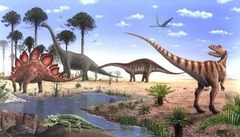
"The Age of the Dinosaurs"—dinosaurs became the most diverse land animals One lineage of dinosaurs evolved feathers and ultimately led to modern birds. evolution of the first mammal

answer
Mesozoic Era
question
Ended with a mass extinction (bye bye dinosaurs!)... possibly brought on by a large impact in the gulf of mexico, Evidence it happened: marks the geologic boundary between the Mesozoic and Cenozoic with a layer of ash and iridium, Unique Quartz Crystals by impact
answer
K-T mass Extinction
question
Mammals fill dinosaurs' shoes (underwent major diversification) Tree dwelling primates appeared Flowering plants, grasses, and insects did well Large grazing mammals evolved First whales evolved Climates changed to favor open woods and grasslands over forests Early hominins adapted to two-footed walking Modern humans evolve
answer
Cenozoic Era
question
Longest time unit in the geological time scale, measured in billions of years.
answer
Eon
question
A subdivision of an eon.
answer
Era
question
A subdivision of geological time that is longer than an epoch, but shorter than an era (subdivision of an era).
answer
Period
question
A subdivision of geologic time that is longer than an age but shorter than a period (subdivision of a period).
answer
Epoch
question
Crater in the Yucatan peninsula of Mexico, recognized as the K-T impact site. Igneous rock contains high levels of iridium (rare earth metal from asteroids) coinciding with the K-T boundary
answer
chicxulub
question
Iridium and ash layer Impact Crater Shocked Quartz
answer
Evidence for the extinction of the Dinosaurs
question
Change over time, the process by which modern organisms have descended from ancient organisms
answer
Evolution
question
Selective breeding of plants and animals to promote the occurrence of desirable traits in offspring
answer
Artificial Selection
question
A process in which individuals that have certain inherited traits tend to survive and reproduce at higher rates than other individuals because of those traits.
answer
Natural Selection
question
A change in the genetics of a population as a result of chance events rather than natural selection.
answer
Genetic Drift
question
4.5 billion years old
answer
How old is the earth
question
Bipedal carnivore with a massive skull balanced by a long, heavy tail. large and powerful hindlimbs. Forelimbs were small, though unusually powerful for their size, and bore two clawed digits. 42 ft in length, up to 4 metres (13 ft) tall at the hips, and up to 6.8 metric tons (7.5 short tons) in weight. Late Cretaceous 67-65.5 My. "The tyrannosaur ate many students at Roxbury High School before it felt satiated."
answer
tyrannosaurus
question
A dinosaur with three horns
answer
triceratops
question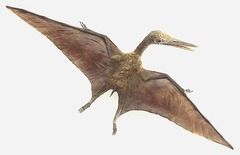
Mesozoic flying reptiles with large, batlike wings

answer
pterosaurs
question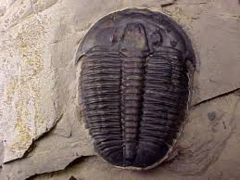
a marine arthropod, now extinct, that lived during the Paleozoic era

answer
trilobite
question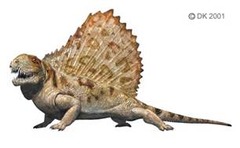
a synapsid; early reptile that gave rise to mammals

answer
dimetrodon
question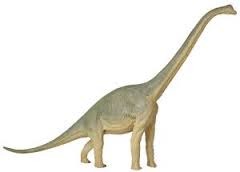
long neck

answer
saruopod
question
28 foot long stegosaur with large pentagonal plates along back,
answer
stegosaurus
question
heavily armored, short-legged dinosaur
answer
ankylosaurus
question
A member of a group of shelled cephalopods that were important marine predators for hundreds of millions of years until their extinction at the end of the Cretaceous period (65.5 mya).
answer
ammonite
question
Birds
answer
What group of animals are related to dinosaurs?
question
The greatest mass extinction event, All life nearly died in a massive wave of extinction around 251 mya in the largest of the so-called "Big Five" mass extinctions, 90% of life goes extinct during the Permian Mass Extinction
answer
The great Dying
question
The fact that oxygen is a major constituent of the present-day atmosphere is a direct consequence of the evolution of life on earth, oxygen played a huge part in shaping what lived on the earth as organisms got more complex Diversity: Complex organisms- A second group, eukaryotes, have complex cells that have compartments with special jobs and DNA in a nucleus Beginnings: Diversity explodes The cambrian explosion: Around 542 mya, several fossil sites show that the diversity of animal life on Earth dramatically exploded over a short time
answer
How have organisms change through times? Simpler or more complex?
question
Volcanoes would have created Earth's first atmosphere (mostly water vapor, carbon dioxide, and others.)
answer
Earth's Early Atmosphere & Water
question
Volcanic outgassing (or) Derived from icy comets
answer
Earth's first oceans came from:
question
Deep Sea vents/hot springs: - Dna evidence suggests that early organisms survived in conditions similar to deep-sea vents - Plenty of chemical energy available
answer
Where did life begin?
question
Earth was difficult to interpret and rocks have been metamorphosed back in the Precambrian eon as the Paleozoic is more recent and the change that happened is more easily notable (etc.)
answer
Why is it hard to find more fossils in the Precambrian period than the Paleozoic?
question
1. The atmosphere got to 1,200 degrees at its max, their blood boiled inside their body (the dino) 2. They all disappeared in at least 2 hours
answer
2 interesting Dino facts
question
---
answer
The Time Line in order:
question
3.5 Ga indicate that oxygen producing organism were present
answer
Banded Iron Formations
question
("recent life") begins ~ 65 ma era of mammals
answer
cenozoic era
question
("middle life") begins~ begins 248 ma era of reptiles
answer
mesozoic era
question
("ancient life") begins 545 mya era of ocean dwelling animals and amphibians
answer
paleozoic



